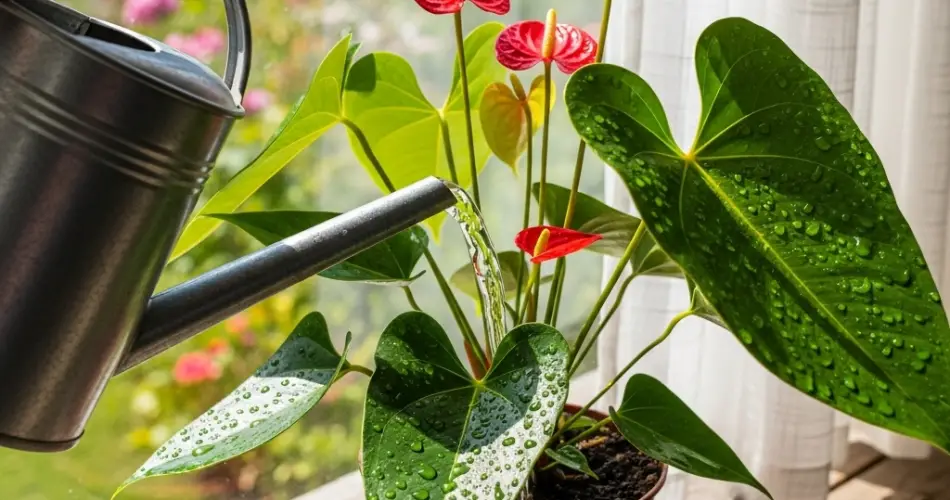Anthuriums, also known as flamingo flowers or laceleaf, are prized for their glossy heart-shaped leaves and bright, waxy blooms. As tropical plants, they thrive in humid environments and need just the right balance of water and airflow around the roots. Whether you’re a beginner or just trying to troubleshoot a sluggish plant, proper watering and drainage practices are essential for keeping your potted anthurium healthy and vibrant.
Understanding Anthurium’s Moisture Needs
Anthuriums are native to the rainforests of Central and South America, where they grow as epiphytes or terrestrials in rich, loose soil with high humidity. Despite this, their roots dislike sitting in soggy conditions. The key to successful indoor cultivation is creating a watering routine that mimics those natural conditions—moist but never waterlogged.
How Often Should You Water a Potted Anthurium?
Watering frequency will vary depending on light levels, temperature, humidity, and the size of your pot. Generally, anthuriums benefit from watering every 5 to 7 days during the growing season (spring and summer), and every 10 to 14 days during fall and winter when growth slows.
Here’s how to determine when your anthurium needs water:
-
Insert your finger into the soil about 1 inch deep. If it feels dry at this depth, it’s time to water.
-
Use a moisture meter for greater accuracy, especially if you’re growing the plant in a less breathable container.
-
Avoid watering on a fixed schedule. Let the soil guide you.
How to Water an Anthurium Correctly
When watering, be thorough:
-
Slowly pour room-temperature water over the soil until you see it drain from the bottom.
-
Allow the plant to sit for 10–15 minutes, then empty any excess water from the saucer to prevent root rot.
-
Mist the leaves occasionally for extra humidity, especially in dry indoor environments, but never use misting as a substitute for proper soil watering.
If your home has hard water or high fluoride levels, consider using distilled water or letting tap water sit out overnight to allow some of the chlorine to evaporate. This can prevent browning leaf tips caused by mineral buildup.
The Role of Drainage in Anthurium Health
Proper drainage is just as important as watering itself. Anthurium roots are sensitive to rot and need air circulation to stay healthy. Here’s how to promote good drainage:
-
Use a pot with drainage holes. Avoid decorative containers that hold water at the bottom unless they include an inner pot with holes.
-
Choose the right soil mix. Anthuriums prefer a chunky, well-aerated mix. You can create your own by combining:
-
1 part orchid bark
-
1 part perlite or pumice
-
1 part high-quality potting mix or coco coir
-
-
Avoid compacted or soggy soils, which can suffocate roots and lead to disease.
Repot your anthurium every 1–2 years to refresh the mix and check for root health. During repotting, inspect roots for softness or discoloration, and trim any damaged parts with sterile scissors.
Recognizing Signs of Overwatering
Overwatering is the most common problem faced by indoor anthurium growers. Watch for these symptoms:
-
Yellowing lower leaves
-
Wilting despite moist soil
-
Mushy or black roots
-
Foul odor coming from the soil
If you notice these issues, stop watering immediately and let the soil dry out. If the problem persists, repot the plant in fresh, dry, well-draining soil.
Signs of Underwatering
Although less common, underwatering can also affect anthuriums. You may notice:
-
Leaf curling or drooping
-
Brown, crispy leaf edges
-
Slow or stunted growth
-
Soil pulling away from the pot edges
To correct this, give your anthurium a thorough drink and adjust your watering frequency. Remember, consistent moisture is key—not soaking, not drying out completely.
Best Environmental Conditions to Support Watering
Watering success also depends on environmental factors. For best results, keep your anthurium in the following conditions:
-
Bright, indirect light—direct sunlight may scorch the leaves, while low light can slow growth and increase the risk of overwatering.
-
Warm temperatures between 65–80°F (18–27°C).
-
Humidity above 60% if possible—use a humidifier, pebble tray, or group plants together to raise humidity naturally.
If you’re growing your anthurium in a particularly dry or cool space, adjust watering accordingly to prevent overhydration.
Final Thoughts
Anthuriums may look exotic, but their care becomes simple once you understand the balance between moisture and airflow. By watering only when the topsoil is dry, using a well-draining mix, and maintaining moderate humidity, your potted anthurium can thrive indoors and continue to produce its iconic blooms year-round.
With proper watering habits and attention to drainage, you’ll enjoy a healthy, lush plant that adds elegance and a tropical touch to any indoor space.



